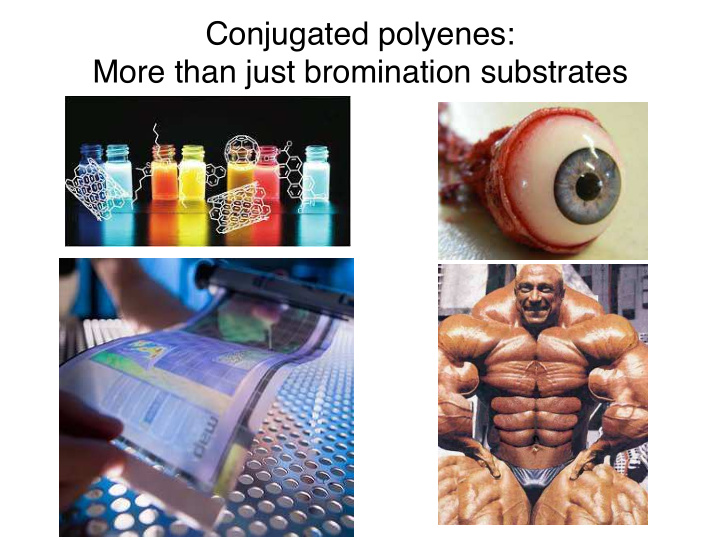



Conjugated polyenes: More than just bromination substrates
The catalyst Phys. Rev. Lett. 1977 , 39 , 1098-1101
Shirakawa ’ s synthesis of “ carbon films ” Exposure to chlorine resulted in a strongly absorbing film …
Shirakawa ’ s synthesis of “ carbon films ” Exposure to chlorine resulted in a strongly absorbing film … Cl Cl Cl Not halogenation but doping , and the birth of organic Cl Cl conducting polymer research Cl Nobel Prize 2000 Cl Cl
A survey of organic photovoltaics (2011) Beaujuge and Fr échet , J. Am. Chem. Soc. 2011 , 133 , 20009-20029
Biosynthesis: From terpenes to … Terpenes contain carbon atoms in multiples of five: • A monoterpene contains 10 carbons. • A sesquiterpene contains 15 carbons. • A diterpene contains 20 carbons. Bruice p 1196
… to terpene oligomers Bruice Ch 25
… to small “essential oils” Bruice Ch 25
… to longer oligomers Bruice Ch 25
Bruice Ch 25
From cis-trans isomerization to vision Bruice page 151
Michael Faraday: just looking for better lamp oil … Oil gas, used to power 19 th century English lamps, left a liquid that deposited on the gas valves and subsequently decreased performance. What was this oil decomposition product? Faraday determined the molecular formula to be C 2 H Michael Faraday (atomic weight of carbon then was 6 …) 1791-1867 Faraday ultimately isolated and described the properties of this product A remarkable feat given that this was done in the 1820s! ““Bicarburet of hydrogen” appears in common circumstances as a colorless transparent liquid, having an odor resembling that of oil gas, and partaking also of that of almonds”
Benzene / phène … and “aromatic” Whence benzene ? Eilhard Mitscherlich distilled benzoic acid (PhCOOH) And a strong caustic base (we now call this “decarboxylation”) Benzoic acid is obtained form benzoin resin, found in SE Asian perfumes Thus, يواج نابل or “Frankincense from Java” (luban jawi) Whence phenyl ? A. Laurent, Ann. Chem. Phys . 1836 , 63 , 27-45
Kekulé’s dream of benzene Bull. Soc. Chem. Paris 1865 , 3 , 98-110 Ouroboros
“Hückel’s rule” and non/antiaromaticity Hückel developed the quantum mechanical framework, a simplified version of which (Hückel MO Theory) can be used quickly to calculate energetics for pi-conjugated systems in 1931. This led to the realization that 6 pi electron circuits Has special stability/resonance/aromaticity. Bill Doering actually coined the “2+4n” rule in 1951 Erich Hückel 1896-1980 Richard Wilstatter Ron Breslow 1872-1942 (Columbia) Synthesized Studied Cyclooctatetraene Cyclopropyl (8 pi-electrons) Anions (4 pi) “non aromatic” “anti-aromatic”
Proof of structure Lewis, Pauling, Hückel, provided theoretical framework. Can we measure? Unlike typical newly married women in 1920s-1930s England who were expected to become scientists, Lonsdale wanted to be homemaker and raise her children. Her husband helped persuaded her otherwise. She published benzene’s structure in 1929 Kathleen Lonsdale 1903-1971 Proc. Royal. Soc. A 1929 , 123 , 494
Mono-substituted benzenes: common names Jones, Fig 12.50
Disubstituted Benzene rings: Common names Jones Fig. 12.54
Recommend
More recommend